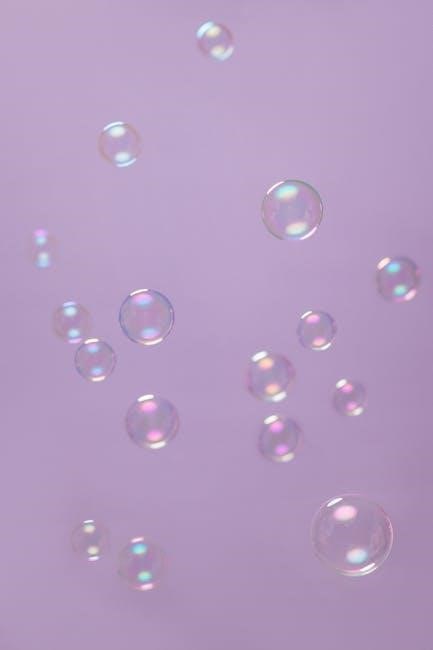Ultra Clear Epoxy is a popular choice for creating durable, high-gloss coatings on surfaces like bar tops and countertops.
These instructions guide you through proper preparation, mixing, application, and curing for professional results.
Overview of Ultra Clear Epoxy
Ultra Clear Epoxy is a high-performance, two-part resin system ideal for creating durable, glossy coatings on surfaces like bar tops, countertops, and tables.
Known for its clarity and resistance to heat and chemicals, it’s perfect for both decorative and protective applications. The epoxy is food-safe once fully cured and offers excellent adhesion to various materials. Proper mixing and application ensure a professional finish. It’s widely used for its versatility, ease of use, and ability to enhance the appearance of surfaces while providing long-lasting protection.
Importance of Following Instructions
Following Ultra Clear Epoxy instructions ensures a safe and successful application. Proper mixing ratios, safety precautions, and environmental conditions are critical for a flawless finish. Incorrect techniques can lead to uneven surfaces, bubbles, or incomplete curing. Adhering to guidelines prevents wasted material and avoids costly rework. This ensures the epoxy achieves its maximum durability, heat resistance, and aesthetic appeal, delivering professional-grade results for your projects.
Understanding the Components
Ultra Clear Epoxy consists of two components: resin and hardener. Stored between 60°F-80°F, they must be kept dry and sealed to maintain effectiveness and shelf life.
Resin and Hardener Components
Ultra Clear Epoxy comprises two essential components: Resin (Part A) and Hardener (Part B). The resin provides the binding properties, while the hardener initiates the curing process; Proper storage between 60°F-80°F is crucial to maintain their effectiveness. Both components should be kept in tightly sealed containers to prevent contamination and degradation. Always ensure the resin and hardener are mixed in the correct ratio to achieve a durable, long-lasting finish.
Storage and Handling Recommendations
Store Ultra Clear Epoxy in a dry, cool place between 60°F-80°F, away from direct sunlight and moisture. Keep containers tightly sealed to prevent contamination and degradation. Handle with care, avoiding spills, as epoxy can adhere to surfaces. Use protective gloves and eyewear when handling. Ensure the workspace has proper ventilation and maintain relative humidity below 60% for optimal application conditions. Always follow safety guidelines to ensure safe handling and storage.

Surface Preparation
Ensure surfaces are clean, dry, and free of contaminants. Lightly sand metal, laminate, and solid surfaces for better adhesion. Remove dust and debris thoroughly before application.
Preparing Metal, Laminate, and Solid Surfaces
A seal coat is not required on metal, laminate, or solid surfaces. Use 4 mil painters plastic to protect surrounding areas from spills. Epoxy can seep through cardboard, so multiple layers are needed if used. Ensure surfaces are clean, dry, and free of grease or dust. Lightly sand metal and solid surfaces to enhance adhesion. Remove all dust and contaminants with a tack cloth or vacuum before applying epoxy for optimal results.
Using Painters Plastic for Protection
4 mil painters plastic is the best choice to protect surrounding areas from epoxy spills. Apply it around your workspace, ensuring a secure seal to prevent leakage. Unlike cardboard, which may require 3-4 layers, plastic provides a reliable barrier. Position it carefully to cover all areas at risk of exposure. This step ensures clean-up is easier and prevents accidental damage to floors or adjacent surfaces. Secure edges with tape for maximum protection.

Safety Precautions
Wear protective gear, including gloves and goggles, and work in a well-ventilated area to avoid inhaling fumes. Ensure proper ventilation to maintain a safe environment.
Protective Gear and Ventilation
Always wear protective gear, including gloves, goggles, and a mask, when handling Ultra Clear Epoxy to prevent skin and eye irritation and avoid inhaling fumes.
Ensure good ventilation by working in a well-ventilated area or using fans to reduce fume concentration. Proper airflow helps prevent dizziness and ensures a safe working environment.
Temperature and Humidity Requirements
For optimal results, apply Ultra Clear Epoxy in a room with a temperature between 60°F and 85°F and relative humidity below 60%.
High humidity can lead to surface cloudiness or prolonged curing times, while extreme temperatures may affect the epoxy’s performance and finish.
Ensure environmental conditions are controlled before starting your project for a smooth and durable application.

Mixing the Epoxy
Measure Ultra Clear Epoxy components accurately, following the recommended resin-to-hardener ratio to ensure proper chemical reactions and curing. Mix thoroughly to avoid uneven results.
Measuring Resin and Hardener Ratios
Accurate measurement is crucial for Ultra Clear Epoxy. Always use a two-to-one ratio of resin to hardener by volume; Use measuring cups or digital scales for precision. Start by pouring the resin into a mixing container, then add the hardener, ensuring both components are at room temperature. Proper measurement ensures the epoxy cures correctly, avoiding issues like soft spots or uneven hardening. Mixing equal parts can lead to poor results, so double-check measurements before proceeding. This step sets the foundation for a successful project, whether coating a table top or creating a deep pour. Consistency is key to achieving a professional finish, so never skip this critical step. Always verify the ratio specified in the product instructions, as variations may occur between brands. For Ultra Clear Epoxy, strictly follow the two-part resin to one-part hardener guideline to ensure optimal performance and durability. This careful process guarantees the epoxy adheres properly and cures to a crystal-clear, hard finish. Measurements should be exact to prevent any chemical imbalances that could affect the final outcome. Using too much or too little of either component can lead to a failed project, so attention to detail is essential. By measuring accurately, you ensure the epoxy’s strength, clarity, and longevity, making your project both visually appealing and long-lasting. This precise mixing ratio is vital for all epoxy applications, from thin seal coats to thick pours, ensuring reliability and quality in every use. Proper measurement is the first step toward achieving professional results with Ultra Clear Epoxy, making it a critical part of the process that should never be overlooked or rushed. Always prioritize accuracy to unlock the full potential of your epoxy project.
Mixing Techniques and Avoiding Exothermic Reactions
When mixing Ultra Clear Epoxy, use a slow, folding motion with a stir stick to combine resin and hardener. Avoid whipping or over-mixing, as this generates excessive heat. Exothermic reactions can cause the epoxy to cure too quickly, leading to bubbles or uneven results. Pour the mixture immediately after combining to prevent heat buildup. Use a heat-resistant container and work in a cool, well-ventilated area. Monitor the mix for signs of heat, and avoid leaving it unattended. Proper mixing ensures a smooth, even finish.
Application Methods
Ultra Clear Epoxy can be applied using brushes, rollers, or squeegees for smooth, even coverage. Brushes are ideal for detailed work, while rollers cover larger areas efficiently. Squeegees help remove air bubbles and excess epoxy, ensuring a uniform finish. Work in thin layers to avoid pooling and promote proper adhesion. Always follow recommended spread rates for optimal results.
Using Brushes, Rollers, and Squeegees
For precise application, use brushes to cover small details or edges. Rollers are ideal for larger surfaces, ensuring smooth, even coverage. Squeegees help remove air bubbles and excess epoxy, promoting a uniform finish. Brushes work best for thin coats, while rollers speed up the process on flat areas. Squeegees are especially useful for spreading epoxy evenly and achieving a professional-looking result. Always work in sections to maintain control and avoid pooling.
Applying Thin vs. Thick Coats
Thin coats are ideal for even coverage and minimizing bubbles, while thick coats provide durability but risk imperfections. Apply thin coats for smooth finishes and thick coats for heavier builds. Ensure proper curing between layers. Thin coats dry faster, reducing wait times, while thick coats may require extended curing periods. Always follow recommended coat thickness to avoid cracking or uneven surfaces. Proper layering ensures a professional, long-lasting finish.

Curing and Drying Times
Curing and drying times are crucial for Ultra Clear Epoxy. The process involves a chemical reaction that hardens the epoxy over time, influenced by temperature and humidity.
Understanding the Curing Process
The curing process involves a chemical reaction between the resin and hardener, transforming the liquid epoxy into a solid, durable finish. This process is influenced by temperature and humidity, with optimal conditions between 60°F and 85°F. The epoxy transitions from a liquid to a gel-like state before fully hardening. Full curing typically takes 24-72 hours, depending on environmental factors, ensuring a strong and long-lasting surface.
Factors Affecting Drying Time
Temperature, humidity, and thickness of the epoxy layer significantly influence drying time. Higher temperatures and lower humidity accelerate the process, while cooler conditions slow it down. Thin coats dry faster than thick ones. Ensuring the environment stays within the recommended 60-85°F range optimizes curing. Proper ventilation also aids in faster drying, as it helps evaporate moisture and accelerates the chemical reaction.
Troubleshooting Common Issues
Identify and resolve issues like uneven surfaces, bubbles, and incomplete curing by adjusting techniques and environmental conditions for optimal epoxy application results.
Dealing with Uneven Surfaces
Uneven surfaces can be addressed by applying multiple thin coats of epoxy, allowing each layer to cure before the next. Use a squeegee or brush to spread evenly. If necessary, sand lightly between coats to ensure a smooth finish. Proper preparation and application techniques are crucial to achieving a uniform appearance. Always follow the manufacturer’s instructions for best results.
Fixing Bubbles and Imperfections
To fix bubbles in Ultra Clear Epoxy, use a torch or heat gun to gently heat the area, allowing the bubble to rise and pop. For small imperfections, use a pin or needle to carefully prick the bubble and smooth it with a credit card. Avoid over-mixing, as this can create air pockets. If imperfections persist, lightly sand the area after curing and apply a thin coat. This ensures a smooth, professional finish.
Maintenance and Care
Regularly clean the epoxy surface with mild soap and water to maintain its appearance. Avoid harsh chemicals and abrasive materials that may damage the finish.
Cleaning and Protecting the Epoxy Surface
Regular cleaning with mild soap and water keeps the epoxy surface looking new. Avoid harsh chemicals or abrasive materials, as they may damage the finish. For stubborn stains, a soft cloth and gentle cleanser can be used. UltraClear epoxy is heat-resistant up to 135°F, making it suitable for kitchen surfaces. To protect the surface further, use placemats or coasters for hot items. Proper care ensures long-lasting durability and maintains the epoxy’s glossy appearance.
Heat and Chemical Resistance
UltraClear epoxy offers excellent heat and chemical resistance, making it ideal for surfaces exposed to spills and moderate heat. The epoxy can withstand temperatures up to 135°F without damage. It resists many household chemicals, including water, alcohol, and mild acids. However, it is not resistant to all chemicals, such as strong acids or solvents. Proper care ensures the surface remains durable and maintains its glossy finish, even in demanding environments.
Additional Tips and Tricks
For custom effects, use fillers like pigments or powders when mixing UltraClear epoxy. Experiment with layering techniques for unique finishes and ensure proper curing between coats.
Using Fillers for Custom Effects
Add unique textures and colors to your Ultra Clear Epoxy projects by incorporating fillers like pigments, glitters, or metallic powders. Mix these additives into the resin before combining it with the hardener for consistent results. Start with small amounts to avoid altering the epoxy’s viscosity. For intricate designs, layer fillers between epoxy coats. Experiment with different materials to create personalized finishes. Always test the mixture on a small surface first to ensure proper bonding and appearance.
Layering and Multiple Coats
Layering Ultra Clear Epoxy allows for enhanced durability and aesthetic effects. Apply a thin initial coat as a sealant, followed by additional coats for thickness. Ensure each layer is fully cured and lightly sanded for proper adhesion. For optimal results, wait 4-6 hours between coats. Avoid over-saturating the surface, as this can lead to uneven drying. Multiple thin coats are preferable to a single thick layer for a smooth, professional finish. Plan your layers in advance to achieve the desired effect.
By following the Ultra Clear Epoxy instructions, you can achieve professional-grade results for your projects. Proper preparation, precise mixing, and patient application ensure a durable, glossy finish. Remember to work in a well-ventilated area and adhere to safety guidelines. With practice, you’ll master techniques for layering, avoiding common issues, and maintaining your epoxy surfaces. Whether for countertops, bar tops, or artistic creations, Ultra Clear Epoxy offers versatility and long-lasting beauty. Happy creating!
